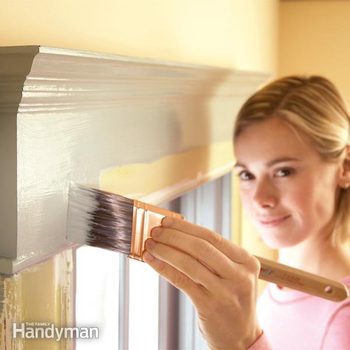Trim Painting Tips
Updated: Feb. 27, 2023Make your walls look perfect, your trim flawlessly smooth and your life drip-free.

Careful sanding is the key to a perfect job
If your woodwork is smooth, just give it a once-over with 120-grit sandpaper. But if your trim is in rough shape like ours, start with 80-grit sandpaper. Switch to 100-grit for smoothing and blending in the areas with layered paint. Finally, go over all the wood with 120-grit. Buy sandpaper labeled ‘no-load.’ No-load sandpaper won’t clog as easily and is better for sanding painted surfaces.
CAUTION
If your home was built before 1979, check the paint for lead. Call your public health department for instructions on how to test for lead and on what to do if you have lead paint.
Fill holes and dents
To repair large dents or gouges on edges that are vulnerable to abuse, use hardening-type two-part wood filler (Minwax High Performance Wood Filler is one brand). Fill smaller dents and holes with spackling compound. Since spackling compound shrinks as it dries, you’ll have to apply a second (and possibly a third) coat after the previous coat dries.
Shine a strong light across the woodwork to highlight depressions and ensure that you don’t miss any spots as you’re applying the filler. Let the filler dry and sand it smooth.
Caulk for a seamless look
Here’s a step that many beginners don’t know about but pros swear by. Caulk every crack or gap, no matter how small. Use latex (Acrylic) caulk or a paintable latex/silicone blend. The key is to cut the caulk tube tip very carefully to create a tiny, 1/16-in.-diameter hole. Fill all the small cracks first. Then, if you have wider cracks to fill, recut the caulk tube tip to make a larger hole. Move the caulk gun swiftly along the cracks to avoid an excess buildup of caulk. If necessary, smooth the caulk with your fingertip. Keep a damp rag in your pocket to clean caulk from your finger and to keep the tip of the caulk tube clean. If caulk piles up in the corners, remove the excess with a flexible putty knife.
Spot-prime to avoid blotches
Brush a stain-sealing primer (B-I-N is one brand of shellac-based primer) over the areas that you’ve patched or filled, and over areas where you’ve sanded down to bare wood. If you have a lot of patches and bare spots, it’ll be faster and easier to just prime the entire surface. Also seal discolored areas or marks left by crayons, pens or markers to prevent them from bleeding through the finish coat of paint.
Add an extender to latex paint
Most pros prefer to use oil-based paint on trim for two reasons: Oil-based paint doesn’t dry as fast as water-based paint, leaving more time to brush. And oil-based paint levels out better than most water-based paints, leaving a smoother surface with few visible brush marks. But because water-based paint is more environmentally friendly, less stinky and easier to clean up, it’s a better choice for DIYers.
You can make water-based paint perform more like oil paint by adding latex paint conditioner. Floetrol is one brand. Conditioners make the paint flow better and slow down the drying time, allowing you more time to spread the paint without leaving brush marks. Check with the manufacturer of the paint you’re using to see if it recommends a particular brand of conditioner.
Paint from a separate pail
Pour paint about 1-1/2 in. deep into a separate pail. A metal painter’s pail (shown); a specialty pail (at paint stores and home centers); or even an empty 5-quart ice cream pail all work great. Placing a small amount of paint in a pail allows you to easily load the bristles of the brush by dipping them about 1 in. into the paint.
Slap, don’t wipe
Slap the brush gently against each side of the bucket to remove the excess paint. This method of brush loading is best for laying on paint because it keeps the bristles fully loaded with paint. To use the brush for cutting-in, follow up by wiping each side of the brush gently on the rim to remove a little more paint.
Cut in edges before you fill the center
Cutting-in is a skill that takes practice to master, but it’s worth the effort. To cut in, first load the brush. Then wipe most of the excess paint off by gently scraping the bristles on the edge of the can. Start by pulling the brush along the edge, but keep the bristles about 1/4 in. away from the wall or ceiling to deposit some paint on the wood. Now return with another brushstroke, this time a little closer. Sneaking up to the line like this is easier than trying to get it perfect on the first try. At the end of the stroke, arc the brush away from the cut-in line. Cut in a few feet and then fill the middle using the lay-on, lay-off technique we show in the next section.
Lay on, lay off
The biggest mistake beginners make is to work the paint too long after it’s applied. Remember, the paint starts to dry as soon as you put it on, and you have to smooth it out before this happens or you’ll end up with brushstrokes or worse. So here’s the tip. Load your brush. Then quickly unload on the surface with a few back-and-forth brushstrokes. This is called “laying on” the paint. Repeat this until you’ve covered a few feet of trim with paint. Don’t worry about how it looks yet.
Now, without reloading the brush, drag the tips of the bristles over the wet paint in one long stroke to “lay off” the paint. Start in the unpainted area and drag into the previously painted trim. Sweep your brush up off the surface at the end of each stroke. Areas wider than your brush will require several parallel laying-off strokes to finish. When you’re done laying off a section, move on and repeat the process, always working quickly to avoid brushing over partially dried paint. Try to complete shorter pieces of trim with a continuous laying-off brushstroke.
Don’t start a brushstroke on already-smoothed paint
Setting the paintbrush on an area that’s already been smoothed out with laying-off strokes will leave an unsightly mark. Try to start laying-off strokes at the end of a trim piece or board, or in an unpainted area. Brush toward the finished area. Then sweep the brush up and off, like an airplane taking off from a runway, to avoid leaving a mark.
Don’t brush across an edge
Brushing across an edge wipes paint from the bristles and creates a heavy buildup of paint that will run or drip. Avoid this by brushing toward edges whenever possible. If you must start a brushstroke at an edge, align the bristles carefully as if you’re cutting-in, instead of wiping them against the edge. If you accidentally get a buildup of paint that could cause a run, spread it out right away with a dry paintbrush or wipe it off with a damp rag or your finger.
Required Tools for this Project
Have the necessary tools for this DIY project lined up before you start—you’ll save time and frustration.
- Caulk gun
Paintbrush, 1-1/2 in. or 2 in.
Required Materials for this Project
Avoid last-minute shopping trips by having all your materials ready ahead of time. Here’s a list.
- Acrylic caulk
- Paint can
- Paint conditioner
- Primer
- Sandpaper
- Spackling compound













